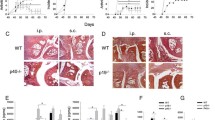Abstract
Objectives
Evidence from the literature that inflammation is a systemic biological phenomenon prompted us to investigate whether inoculation of different irritants to the footpad of mice might influence the kinetics of resident peritoneal cells.
Methods
Mice were inoculated in the footpad at different time intervals with Mycobacterium bovis bacillus Calmette-Guerin (BCG), Ehrlich ascitic tumor cells or lipopolysaccharide (LPS), and resident peritoneal cells were analyzed by flow cytometry.
Results
The results indicate that different stimuli induced different responses in resident peritoneal cells. FoxP3 positive regulatory T cells increased drastically in number after BCG inoculation. Conversely, tumor cell inoculation induced a decrease in FoxP3-positive T cells in the peritoneal cavity, although this effect was not statistically significant. Results also show that cells from the paw migrate to the popliteal lymph node and to the peritoneal cavity. Yet, there are cells in the peritoneal cavity that migrate to the popliteal lymph node.
Conclusion
These data show that cells from the peritoneal cavity are influenced by pathologies in remote regions of the animal. How this novel phenomenon influences overall immune responses, courses of infection and tumor growth are open to further investigation.








Similar content being viewed by others
References
Lenzi HL, Oliveira DN, Borojevic R, Lenzi JA. Milky spots reaction to schistosomal mansoni infection. Mem Inst Oswaldo Cruz. 1992;87(Suppl 5):111–6.
Lenzi HL, Oliveira DN, Pelajo-Machado M, Borojevic R, Lenzi JA. Coelom-associated lymphomyeloid tissue (milky spots): site of lymphoid and myelomonocytic cell generation. Braz J Med Biol Res. 1996;29:19–24.
Panasco MS, Pelajo-Machado M, Lenzi HL. Omental and pleural milky spots: different reactivity patterns in mice infected with Schistosoma mansoni reveals coelomic compartmentalisation. Mem Inst Oswaldo Cruz. 2010;105:440–4.
Almeida SR, Aroeira LS, Frymuller E, Dias MA, Bogsan CS, Lopes JD, et al. Mouse B-1 cell-derived mononuclear phagocyte, a novel cellular component of acute non-specific inflammatory exudate. Int Immunol. 2001;13:1193–201.
Hayakawa K, Hardy RR, Parks DR, Herzenberg LA. The “Ly-1 B” cell subpopulation in normal immunodefective, and autoimmune mice. J Exp Med. 1983;157:202–18.
Staquicini FI, Tandle A, Libutti SK, Sun J, Zigler M, Bar-Eli M, et al. A subset of host B lymphocytes controls melanoma metastasis through a melanoma cell adhesion molecule/MUC18-dependent interaction: evidence from mice and humans. Cancer Res. 2008;68:8419–28.
Oliveira HC, Popi AF, Bachi AL, Nonogaki S, Lopes JD, Mariano M. B-1 cells modulate the kinetics of wound-healing process in mice. Immunobiology. 2010;215:215–22.
De Lorenzo BH, Brito RR, Godoy LC, Lopes JD, Mariano M. Tolerogenic property of B-1b cells in a model of allergic reaction. Immunol Lett. 2007;114:110–8.
Relvas WG, Izar MC, Segreto HR, Giordani AJ, Ihara SS, Mariano M, et al. Resident peritoneal inflammatory cells are pivotal in the development of experimental atherosclerosis. J Atheroscler Thromb. 2010;17:378–85.
Sinhorini IL, Merusse JL, Mariano M. Role of lymphatic drainage on the development of Calmette-Guerin bacillus-induced granulomas in the hamster. Int Arch Allergy Immunol. 1994;103:166–74.
Garcia-Leme J, Farsky SP. Hormonal control of inflammatory responses. Mediators Inflamm. 1993;2:181–98.
Hamamura L, Garcia Leme J. Neurogenic inflammation in the rat. Evidence for the release of a permeability factor from sensory nerves following electrical stimulation. Agents Actions. 1973;3:381–2.
Atkinson DC. A comparison of the systemic anti-inflammatory activity of three different irritants in the rat. Arch Int Pharmacodyn Ther. 1971;193:391–6.
Atkinson DC, Hicks R. Relationship between the anti-inflammatory and irritant properties of inflammatory exudate. Br J Pharmacol. 1971;41:480–7.
Normann SJ, Schardt M, Sorkin E. Antileukocyte activity I. Systemic inhibition of cellular emigration following local inflammation. J Leukoc Biol. 1985;37:319–30.
Acknowledgments
We are indebted to Prof. Esper Kallás from the University of São Paulo for providing us with the use of the FlowJo program and the FACSCanto cytometer. We are also grateful for the skillful suggestions and comments of Mauro Nogueira Martins, Ronni Rômulo Novaes e Brito and Tatiana C. C. Oliveira. This work was supported by Fundação de Amparo à Pesquisa do Estado de São Paulo–FAPESP.
Author information
Authors and Affiliations
Corresponding author
Additional information
Responsible Editor: Michael Parnham.
Rights and permissions
About this article
Cite this article
Palos, M.C., Azevedo, M.C.A., Thies, F.G. et al. Different inflammatory stimuli in the footpad of mice influence the kinetics of resident peritoneal cells. Inflamm. Res. 61, 1187–1194 (2012). https://doi.org/10.1007/s00011-012-0514-y
Received:
Accepted:
Published:
Issue Date:
DOI: https://doi.org/10.1007/s00011-012-0514-y




